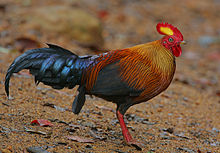Gamebird
| Galliformes Temporal range: Eocene-Holocene, 45–0 Ma |
|
|---|---|
 |
|
| Male Ceylon junglefowl (Gallus lafayetii) | |
| Scientific classification | |
| Kingdom: | Animalia |
| Phylum: | Chordata |
| Class: | Aves |
| Clade: | Pangalliformes |
| Order: |
Galliformes Temminck, 1820 |
| Extant families | |
|
|
| Synonyms | |
|
Gallimorphae |
|
Gallimorphae
The Galliformes are an order of heavy-bodied ground-feeding birds that includes turkey, grouse, chicken, New World quail and Old World quail, ptarmigan, partridge, pheasant, junglefowl and the Cracidae. The name derives from "gallus", Latin for "cock" or "rooster". Common names are gamefowl or gamebirds, landfowl, gallinaceous birds, or galliforms. "Wildfowl" or just "fowl" are also often used for the Galliformes, but usually these terms also refer to waterfowl (Anseriformes), and occasionally to other commonly hunted birds. This group has about 290 species, one or more of which are found in essentially every part of the world's continents (except for the innermost deserts and perpetual ice). They are rarer on islands, and in contrast to the closely related waterfowl, are essentially absent from oceanic islands—unless introduced there by humans. Several species have been domesticated during their long and extensive relationships with humans.
This order contains five families: Phasianidae (including chicken, quail, partridges, pheasants, turkeys, peafowl and grouse), Odontophoridae (New World quails), Numididae (guineafowl), Cracidae (including chachalacas and curassows), and Megapodiidae (incubator birds like mallee fowl and brush-turkeys). They are important as seed dispersers and predators in the ecosystems they inhabit, and are often reared as game birds by humans for their meat and eggs and for recreational hunting. Many gallinaceous species are skilled runners and escape predators by running rather than flying. Males of most species are more colorful than the females. Males often have elaborate courtship behaviors that include strutting, fluffing of tail or head feathers, and vocal sounds. They are mainly nonmigratory.
...
Wikipedia
